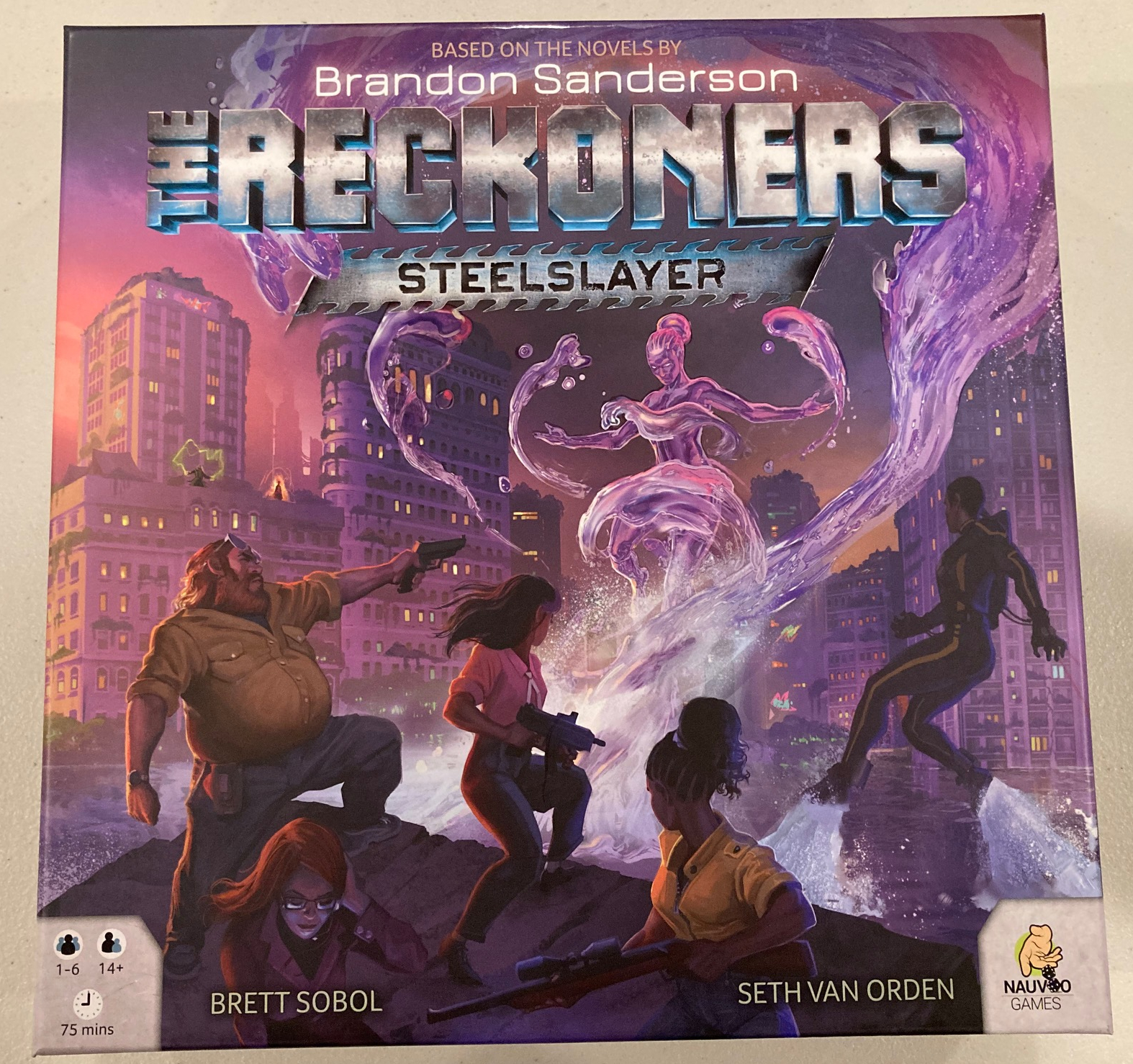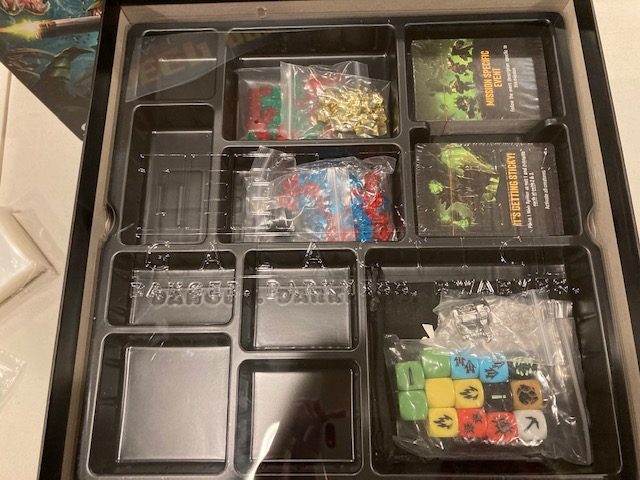
Lord of the Rings: Adventure Book Game is a cooperative game for 1-4 Players, Ages 10+, set in the world of Lord of the Rings.
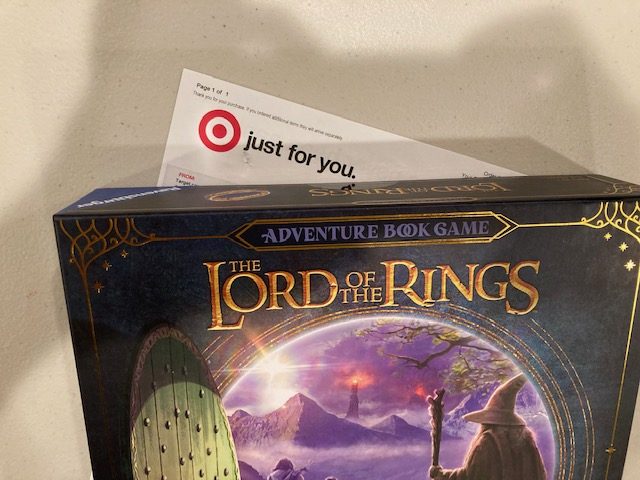
I ordered this online (from Target) in late January and it just got to my house yesterday (Feb 27th, 2023): I believe it was just released. This came from Target, and I believe this is a Target exclusive.

We’ve had some amazing luck with cooperative games from Target over the past year: Minecraft: Portal Dash, Horizons of Spirit Island, and Star Wars: The Clone Wars Pandemic! Let’s take a look and see if this game lives up to the Target hype!
Unboxing

Note: No shrink wrap on the game: the edges are all plastic sticker shut. It looks weird, but that’s the way other games from Target (Disney Sidekicks, The Princess Bride, others) have been! I suspect there’s no shrink wrap to save money.
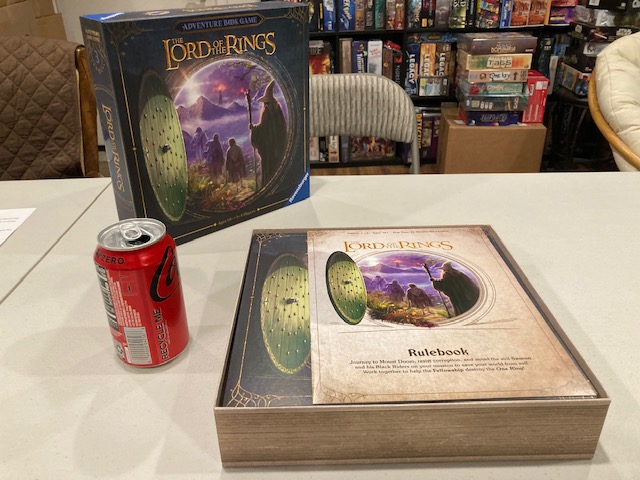
It’s smaller than the standard Ticket TO Ride size box (see above with Coke Can for scale), but it’s the same size as the The Princess Bride Adventure Book Game we reviewed some time ago.
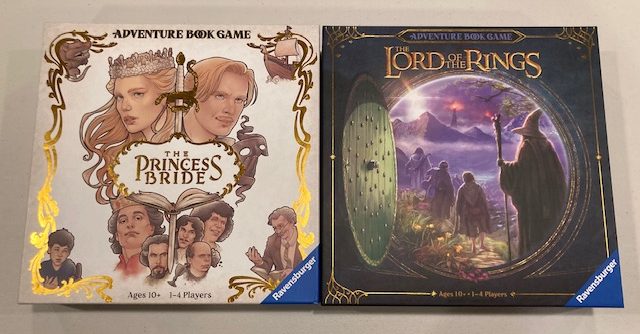
The rulebook on top is decent:
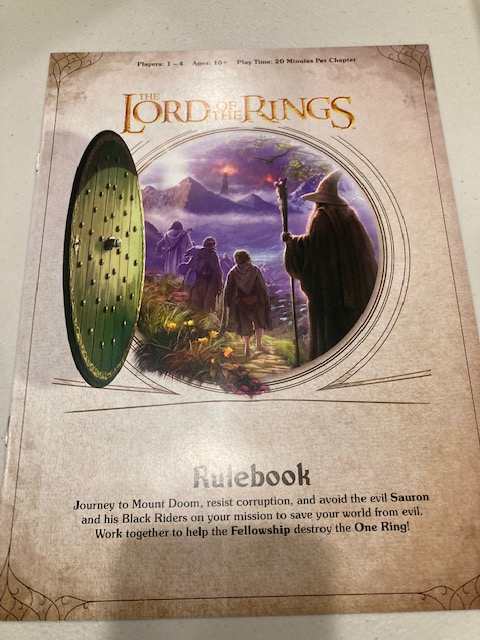
The Adventure Book is very cool and has thick cardboard:


And there’s not a lot in here: some cards, some minis and some tokens.

Weirdly, we don’t have to punch out any tokens: they all come prepunched! So, it’s cheaper to unpunch tokens than put shrink wrap on a box? This seems a weird tradeoff to me, but what the hey: it’s easier to unbox when everything’s unpunched already!

The game is pretty decent, although I wish the cards were linen-finished: After playing all the way the game twice, I think the cards really should be sleeved! So, my main component issue is that the cards either need to be sleeved or be better quality.
Rulebook

The rulebook is good: it’s concise.

It’s only 8 pages! It starts off with a component overview and set-up:
The font is nice, the rulebook is easy to read, and it passes the Chair Test with a A.
There’s even a FAQ per chapter that crosses to the last page. This rulebook was easy to read and easy to consult when we had questions. It was good.
Components and Unboxing

The main component of the game is the Adventure Book. The game is a light legacy game, where players progress across 8 “chapters” in the book to try to throw the ring into Mount Doom.

The book unfolds into a 2-page spread for each chapter: see above.

Each Chapter will have a very specific set-up: See above! Note that this is where we decide what figures to place on the board: In Chapter 1, it’s the Hobbits and Aragorn.

Surprisingly, players do NOT take the role of one of the titular Lord of the Rings characters: instead, players collectively will be manipulating all the characters that come into play.

To the right of board are the Challenges: players will need to fulfill the preconditions of each challenge, then discard some cards (see the colored symbols).

The cards to discard are the Story Cards: see above. There are 6 main types (above).

There’s also some Special Story cards which the players earn as they move through the game: these cards have really cool special abilities (or can be used as a wild card).

The Ring cards are powerful because they can either (a) be wild or (b) be used in special “per scenario” uses (see above: the ring can move the Black Riders). But everytime you play (or discard) on the rings, you cause corruption.

Corruption is kept track of at a special board at the top of the board. If your corruption ever makes it to slot 15, the entire game is over and you lose! If you hit any of the eye symbols along the way, you cause corruption cards to come out, which have bad effects: see below.

So, to be clear: this is a legacy game on many fronts! Corruption you gain will stay for the entire game! When you start a new CHapter of the book, you retain the Corruption track from the previous game! Use too many Ring cards, and you will lose the game before you ever get to Mount Doom!

The Specials stay as well: (as long as you win the game where you gained that special).

To remind myself of where I left off, I take a picture of the cards I gained and the current state of the Corruption track: see above.

This game follows the path of many cooperative games: Player does good news, then bad news happens. Next player does good stuff, then bad stuff happens. Repeat until you win! The good news is done by playing the Story Cards: see above.

The Bad News cards (called Plot Cards) are numbered 1 to 15, and cause bad News t happen, depending on the Chapter you are in!

See above: Plot Card 10 causes 1 Black Rider to move 2 Spaces in Chapter one.

This mechanism is a simple way to vary to bad news per chapter: the Plot Cards are just an index to the Plot Chart (see below).

If you can defeat all challenges in your Chapter, you win! If you complete all 8 chapters and throw the ring into the Volcano, you win! There are many ways to lose along the way, but usually that just means resetting the last chapter and replaying. Unfortunately, if the Corruption ever makes to 15, the game is completely over: you lose.

Solo Play

For a Mass Market game from Target, the Solo Rules are surprisingly well specified (thank you for following Saunders’ Law)! There’s one paragraph in the rulebook (see above). The only real change is that there is an “phantom hand” of 6 cards you can trade with.

See a set-up for a solo player above. My cards are just below the board, and the “phantom hand” of 6 is off to the side.

I had an absolute blast playing this solo. The rules are very simple, and the gameplay is very simple, but it feels like every action you take in the game matters! Without even thinking, I played through the first three chapters one night and finished it the next night!

What makes this so fun is that you are making interesting decisions: Do I use a ring, even though it will cause corruption? Who should I move to always progress? Should I discard now to defeat a challenge or wait until I have more cards? The game has an inherent timer (you lose the chapter if you reveal all 15 plot cards), so everything you do (especially in the later chapters) matters.

The other thing I started doing was keeping track of what cards have come out: I can probabilistically predict what Plot Card might come out next, and that can inform my play! See above as I have all the Plot Cards out by category!

One thing I noticed is that the “phantom hand” the solo player trades tends to fill up with Rings At least mine did: I play to avoid corruption, so I tended to pass all the Ring cards over the Phantom as I used his “other” cards. See above: the “phantom hand” has all Rings! As we’ll see in cooperative play, there is a very different dynamic with the Rings!

I had a phenomenal time playing this solo. I lost one chapter, but each chapter is short: 15-25 minutes! So, even if you need to replay a chapter, it’s quick!
Cooperative Play

Sara and I played through the entire campaign on a blustery Sunday morning (and into lunch). The game was so much fun, we wanted to keep playing! We wanted to get to the end and win! It was a ball!

Sara even brought her “Eyes of Sauron” water cup.

The main difference in our game is that Rings because more like “Wounds” in a deck-builder game: they took up space, since you can only have 6 cards in your hand! See above as I have 2 Rings taking up space in my hand. Again, we tend to play to only use ROngs when you have to, so the Rings (for us anyways) took up space. So, we ended up trading Rings back and forth as we played (I need a Sword: I’ll trade you a Ring!). This was a very different dynamic from the solo game, where the Rings just drifted into the “phantom hand”: we had to share/load-balance the Rings so we both had enough slots in our hand to do stuff!
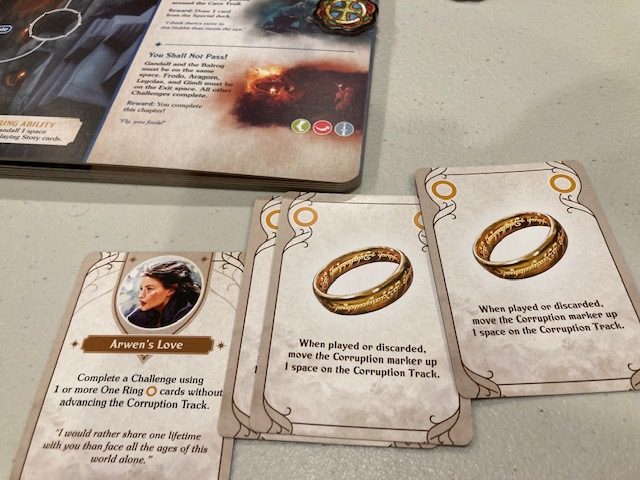
One of things that completely saved our Bacon many, many times was Arwen’s love: that Special card (see above) was earned in the first chapter. It allows use to use Rings without their corrupting effect! This card was huge for us! It allowed us to do challenges and get rid of the “blocking Rings” from our hand! Both Sara and I wondered if we could have won the game without these.

We just barely won at Mount Doom: it could not have been closer. One fewer card, and we would have lost. As it was, we still had to play 4 Rings and take 4 Corruption to win on the last play!!! Luckily, we had kept the corruption down to pretty low in the game, so it wasn’t that bad. We won!!
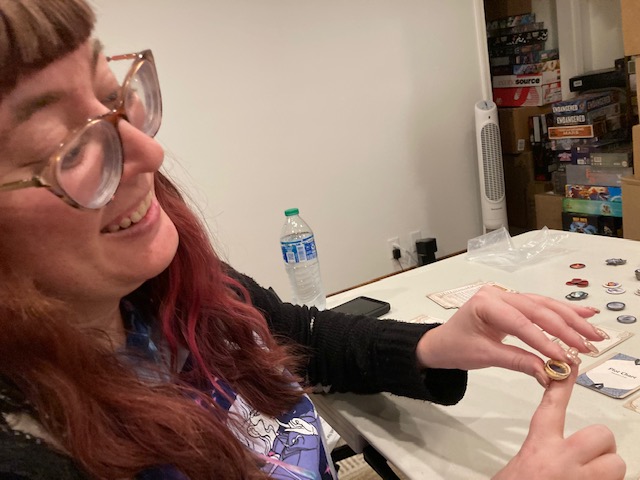
What a fantastic time we had. Each Chapter was quick and very different, and we had a ball.
We do think that 2-Player is optimal: players can strategize closely to keep challenges under control. Much like Pandemic is easier with two players, but more chaotic and harder with more players, Lord of the Rings: Adventure Book Games is probably best at 2 players, and not quite as good at 3 and 4 players.
Two Issues

Issue 1: In general, the components are pretty good (especially for a Mass Market game from Target), but the cards really need to sleeved, or should be better quality. After playing solo and cooperatively all the way through a couple of times, the card are starting to get a little grody: you touch them and shuffle them all the time. Consider sleeving your cards before you play (if you pick this up).
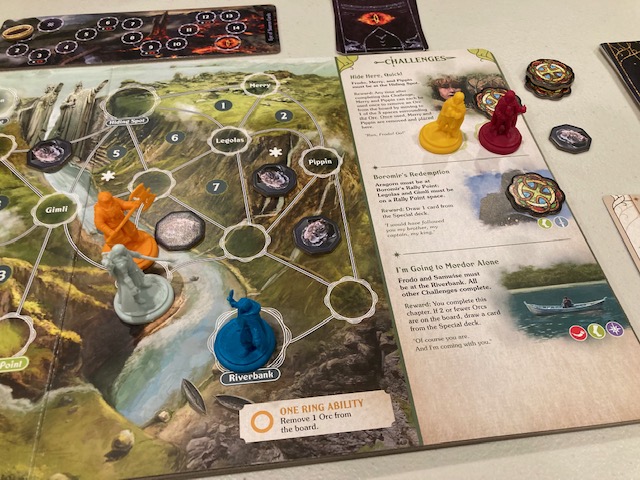
Issue 2: There is an element of Luck. I lost one game (see above) horribly because I could not get a sword for like 4 turns in a row, and that just caused wasted turns. I couldn’t have done anything to mitigate it, I couldn’t skip my turn to draw extra cards or anything like that. Bad Luck as only been an issue a handful of times (and I have played it quite a bit), but it is possible you could get completely screwed on card draws. Luckily, the games are quick: a typical game is 20 minutes, and you can reset quickly. I’ve had many of game of Pandemic go bad because of bad card draws, so it can happen in any cooperative game. The good news (based on my many plays) is that Bad Luck doesn’t seem to happen very often: mostly, you just have toi make smart decisions.
Adventure Book Games

There are currently three Adventure Book games: The Princess Bride (which reviewed here), The Wizard of Oz, and Lord of the Rings (whose review you are reading now). There are all very similar: players cooperatively play cards to move characters around the board and fulfill challenges, and bad news comes with the Plot Decks and Plot Charts. It’s a fairly simple system which seems to work really well for putting on top of a Intellectual Property.
I think The Lord of The Rings Adventure Book Game is my favorite of the three: it slightly evolves the mechanisms of the original Princess Bride and has just a little more content. But, I like them both.
The Oliphant In The Room

So, if given a choice, which cooperative Lord of the Rings board game would I play? The Renier Knizia Lord of the Rings (2001) game has a lot of nostalgia, and I do enjoy playing it, but it is too hard: it would have to be the right group and circumstances to play. I thought the Fantasy Flight Lords of the Rings: Journeys in Middle Earth was just okay: you couldn’t just open it up and play, you had to always be in the middle of a campaign. (And I like Mansion of Madness a lot more if I want that system: you can always just jump into a game).

Lord of the Rings: Adventure Book Game is by far the lightest and easiest to get into. You also can easily “cheat” and jump into any chapter for fun. It’s also incredibly thematic, given how simple it is. It may be too simple for some gamers: you may prefer the complexity of Journeys in Middle Earth, but I think the simplicity of Lord of the Rings: Adventure Book Game is very appealing. I think it’s my favorite?
Replayability
One question you might ask: how replayable is this? I’ve played through the full campaign twice already (once as a solo player, and once as a 2-Player cooperative play), and I still want to play again! Each chapter is different enough to give some variety, and there are 8 chapters: so that’s quite a bit of variety. I am also interested in seeing how the Specials you get as you advance affect the game: Arwen’s Love made a huge difference for us: will other Specials be as useful?
At some point, of course, you might get sick of this system and the chapters. But I think it’ll be a while before you do.
Age Range

The Age Range (according to the rulebook) is 10+. I’d say that’s accurate … at first. The game scales up in difficulty and complexity as you play. I think having an older player needs to be available to either play with younger players or just shepherd younger players through the game. Each Chapter has a lot of rule changes, and I think an older player needs to be around to helper younger players.
Conclusion

I did not expect to like Lord of The Rings: Adventure Book Game as much as I did. I’d probably give it an 8 or an 8.5/10 as would Sara. This works fantastic as a solo game: I still want to replay through the whole campaign even though I’ve already played once before! And this is easy to take out for a cooperative game. My only reservation is that the 2-Player cooperative game is probably optimal (for fun, for winning): A 3-Player game would be okay, but I worry that the 4-Player game might bog down.
This light legacy cooperative game is thematic, fun, quick, and easy to play. It’s my favorite game in the Adventure Book series of games.
























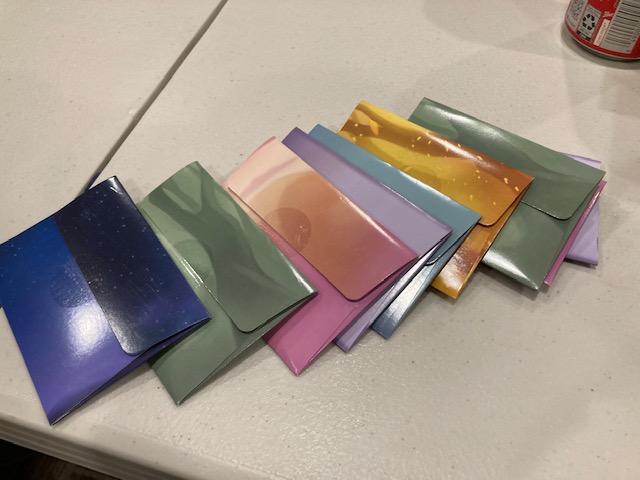

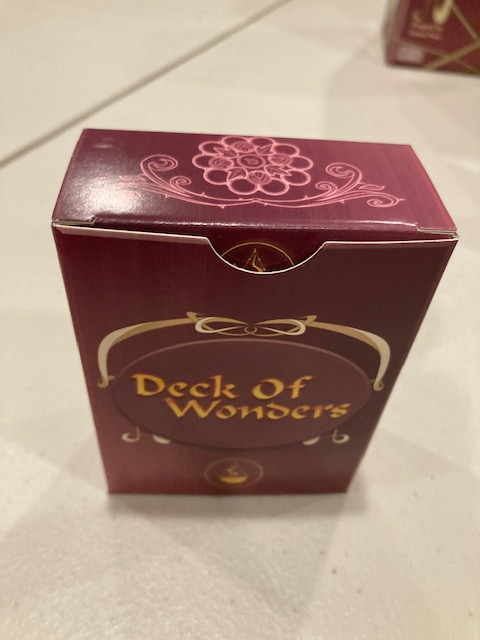




















































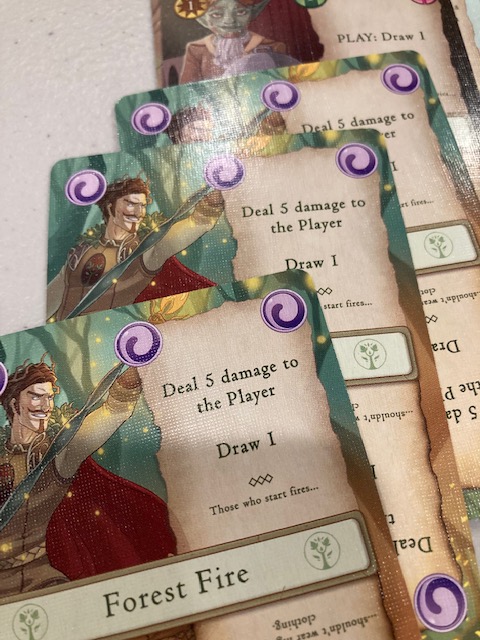

























































































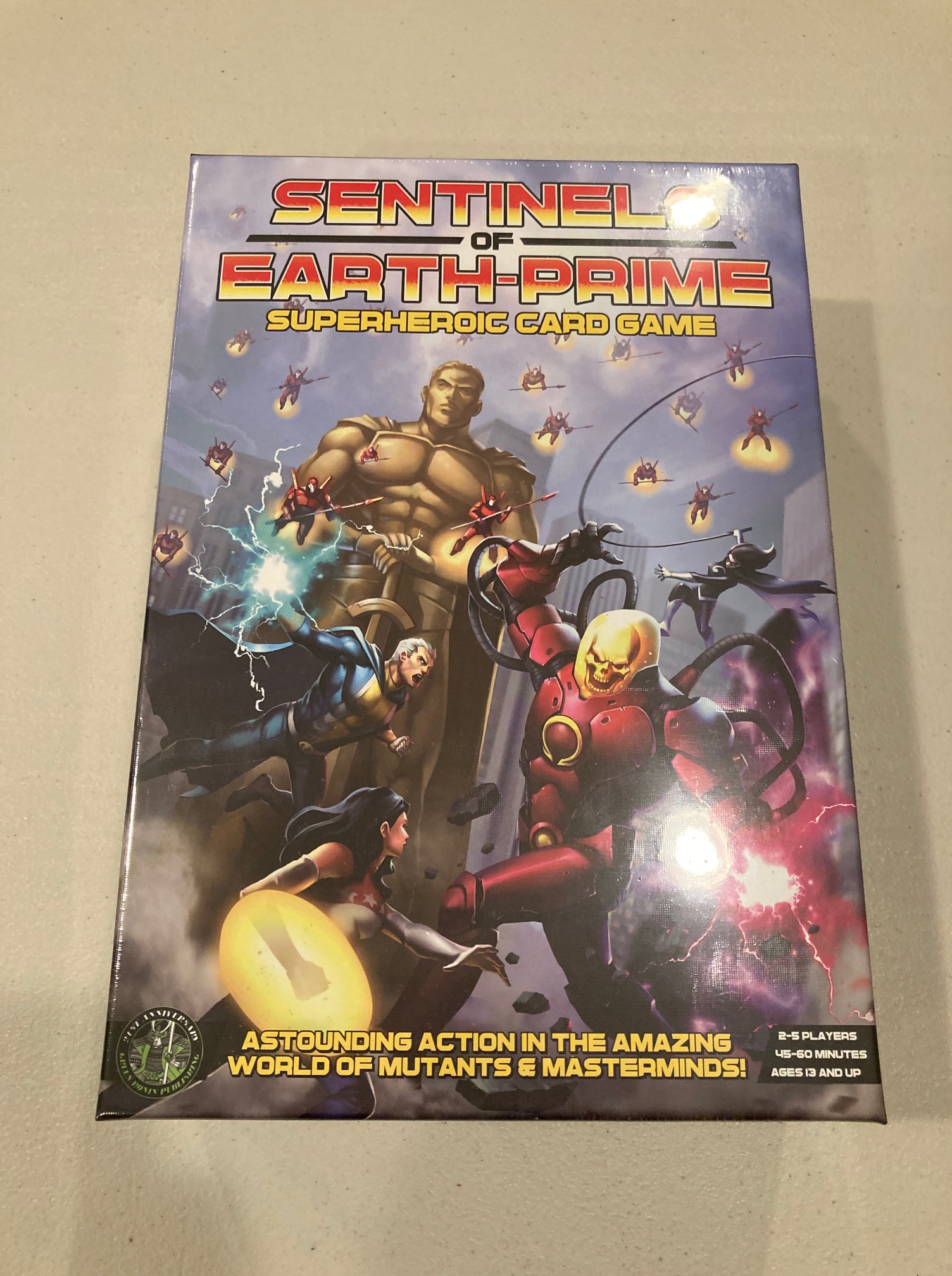







 The Fantastic Four expansion really makes Marvel United a better game: more minis, more heroes, more villains, more teamwork! See
The Fantastic Four expansion really makes Marvel United a better game: more minis, more heroes, more villains, more teamwork! See




